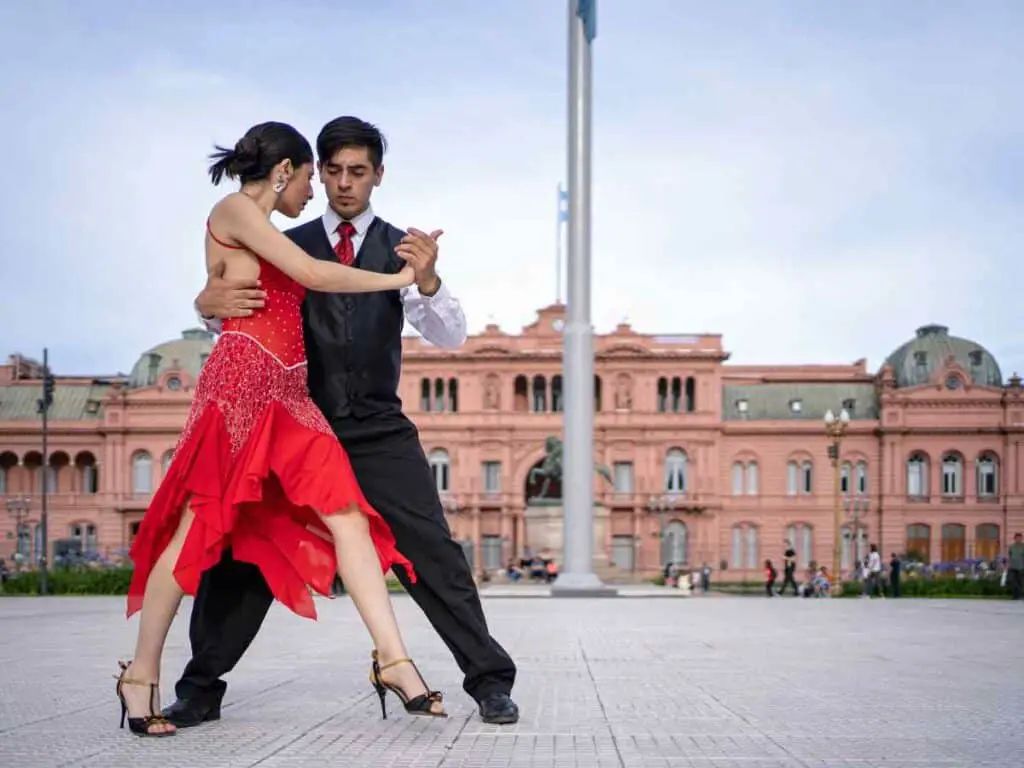
Tango is a popular dance that originated in Argentina in the late 19th century. It is a passionate and sensual dance that is performed by couples. Tango is known for its sharp and sudden movements, intricate footwork, and intimate embrace between the dancers. It is danced to music with a distinct rhythm and melody, usually played by a bandoneon, an accordion.
Tango is not just a dance but also a cultural and social phenomenon that reflects the spirit and history of Argentina. It has been influenced by many different cultures, including African, Spanish, Italian, and indigenous, resulting in a unique and rich dance form recognized worldwide.
There are many different styles of Tango, each with its distinct characteristics and influences. The most well-known styles are Argentine, International Tango, and American Tango.
Argentine Tango is the original style of Tango and is considered the purest and most original form of dance. It is danced in close embrace, with the partners facing each other and moving. Argentine Tango is improvisational and focuses on the connection and communication between the dancers.
International Tango is a more structured and choreographed style performed in competitions worldwide. It emphasizes precise footwork and technique and is often danced in an open embrace, with the partners standing apart.
American Tango is a hybrid style combining Argentine and International Tango elements. It is often distinguished by long, sweeping movements and a more upright posture.
Tango has many benefits, both physical and mental. It is an excellent form of exercise that can improve cardiovascular health, balance, and coordination. It also requires mental focus and concentration, which can help improve cognitive function and reduce stress and anxiety. Tango is also a social dance that can help improve communication skills and build new friendships and connections.
Tango is a fascinating and beautiful dance that has captured the hearts of people around the world. Whether you are interested in its cultural history, its physical benefits or want to experience the thrill of the dance, there is something for everyone in the world of Tango.
What Are the Benefits Of Tango Dance
Tango is a dance that originated in the 19th century in the suburbs of Buenos Aires, Argentina, and Montevideo, Uruguay. It is a dance illustrated by a strong connection between the partners, intricate footwork, and sensual movements. Tango has become popular worldwide and is now considered a form of art and an important cultural heritage of Argentina. Tango offers its practitioners numerous physical, mental, and emotional benefits along with its elegance and grace.
Further in this article, I will explore some of the benefits of Tango dance.
- Tango improves cardiovascular health. Tango is a physically demanding dance that requires continuous movement and quick footwork, and it is an excellent way to get your heart rate up and improve your cardiovascular health. Regular Tango practice can help lower blood pressure, reduce the risk of heart disease and stroke, and increase stamina and endurance.
- Tango improves balance and coordination. Tango involves complex movements that require extraordinary balance and coordination. Practicing Tango can improve your balance and stability, as well as your overall coordination and body awareness. This can particularly benefit older adults at risk of falls and balance-related injuries.
- Tango improves posture. Tango requires dancers to maintain an upright posture and hold their bodies in a specific way. Regular practice of Tango can help to improve posture and reduce back pain. The dance also involves a lot of twisting and turning, which can help to increase spinal flexibility and mobility.
- Tango helps with stress relief. Dancing is a great way to relieve stress and improve your mood. Tango, in particular, is known for its sensual and passionate movements, which can help to release tension and promote feelings of relaxation and well-being.
- Tango helps with social connections. Tango is often danced in pairs and requires a strong connection between partners. Practicing Tango can improve communication and social skills and build friendships and a sense of community.
- Tango helps with confidence. Tango requires dancers to move with confidence and poise. Regular practice of Tango can help to build self-confidence and improve self-esteem.
- Tango helps with creativity. Tango is a highly expressive dance that allows dancers to explore their creativity and emotions. It provides a platform for self-expression and can be a powerful outlet for emotional release and personal growth.
- Tango helps with cultural awareness. Tango’s rich cultural history is an important part of Argentinean culture. Learning and practicing Tango can deepen your appreciation for different cultures and broaden your horizons.
Tango is a beautiful, elegant dance with numerous physical, mental, and emotional benefits. It is a great way to stay active, improve balance and coordination, relieve stress, build social connections, and express yourself creatively. Whether a beginner or an experienced dancer, Tango is a beautiful way to enhance your well-being and enrich your life.
What Is The Difference Between Argentino Tango and Traditional Tango
Argentine and traditional Tango are two distinct forms of dance that have evolved over the years in different parts of the world. While they share some similarities, there are also some significant differences.
The traditional Tango originated in the late 19th century in the working-class neighborhoods of Buenos Aires, Argentina. It was a popular social dance influenced by various musical styles, including African, Cuban, and European. The dance was portrayed by intricate footwork, a close embrace between the partners, and a strong emphasis on connecting the music and the dancers’ movements.
In contrast, Argentine Tango is a more recent development that emerged in the 20th century. It was heavily influenced by jazz music and is generally danced in a more open embrace, with more fluid and spontaneous movements. Argentine Tango also emphasizes the connection between the partners, focusing more on the leader-follower dynamic.
Another significant difference between the two styles of Tango is the music. Traditional Tango is typically danced to the classical Tango music of the early 20th century, represented by its bandoneon, guitar, and violin use. On the other hand, Argentine Tango is usually danced to a wider variety of music, including jazz, electronic, and even pop.
Despite their differences, both forms of Tango share many benefits. Tango is a great way to stay physically fit, as it is a low-impact aerobic exercise that can help improve balance, coordination, and flexibility. It is also a great way to improve mental health, as it requires a lot of focus and concentration, which can help reduce stress and improve mood.
In addition to the physical and mental health benefits, Tango is a great way to build social connections. Tango is often danced in pairs, which can help make strong bonds between partners. It is also a social dance usually enjoyed in a group setting, which can help build a sense of community and belonging.
Final Words
While there are some differences between traditional Tango and Argentine Tango, both forms of dance offer a range of benefits. Whether you want to improve your physical fitness, mental health, or social connections, Tango is a great way to achieve these goals while having fun and enjoying the beauty and elegance of this beautiful dance.
Happy dancing!

